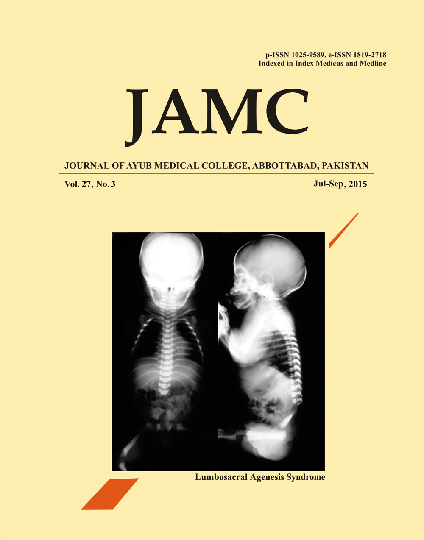INTRAVITREL BEVACIZUMAB IN DIFFERENT TYPE OF RETINAL VEIN OCCLUSIONS
Abstract
Background: Retinal vein occlusion is frequent cause of visual loss with insufficient treatment options. Many treatment options have been tried in the past including intravitreal triamcenoloneacetonide injection. This study was conducted to evaluate the efficacy and complications of intravitreal injection of Bevacizumab in different types of retinal vein occlusion. Methods: This interventional study was carried out at Al Ibrahim eye hospital, Karachi from July 2011 to December 2012. Patients diagnosed with retinal vein occlusion of any type were included in the study using non-probability purposive sampling technique, after informed written consent. Patients were injected intra-vitreally with Bevacizumab 1.25 mg/0.05 ml under sterilized technique in operation room. Best corrected visual acuity and optical coherence tomography was repeated in every follow up along with the detailed fundoscopy and intraocular pressure measurement. Data analysis was done using SPSS-20.0. Results: A total 278 patients were included in the study according to the inclusion and exclusion criteria. Mean age of the patients was 54.28 years (SD=5.62). Out of 278 patients included in the study, 132 had BRVO, 141 had CRVO while 5 had HRVO. Mean visual acuity before injection was 2.309 lines of Snellen’s acuity chart read, with minimum of 1 line read and maximum of 4 lines read (standard deviation=1.00). After 12 weeks post injection, 92 patients read 7 lines (6/6) of Snellen’s visual acuity chart. Mean visual acuity was 4.75 lines of Snellen’s acuity chart read, with minimum of 1 line read and maximum of 7 lines read (standard deviation=1.00). 77% of the patients had visual improvement after injection (p<0.05). Conclusion: Intravitreal bevacizumab injection is very effective in reducing macular thickness as well in improving visual acuity in all types of retinal vein occlusion.References
Glacat- Bernard A, Zourdaine A, Milhoub M, Maraqua N, Cosacs G, Soubrane G. Effect of isovolemic hemodilution in central retinal vein occlusion. Graefes Arch Clin Exp Ophthalmol 2001;239(12):909–14.
Wolf S, Arend O, Bertram B, Remky A, Schulte K, Wald KJ, et al. Hemodilution therapy in central retinal vein occlusion. One year results of prospective randomazied study. Grafes Arch Clip Exp Ophthalmol 1994;232(1):33–9.
Rogers S, McIntosh RL, Cheung N, Lim L, Wang JJ, Mitchell P, et al. The prevalence of retinal vein occlusion: pooled data from population studies from the United States, Europe, Asia, and Australia. Ophthalmology 2010;117(2):313–9.
Mahar PS, Memon AS. Frequency and Management of Raised Intraocular Pressure Following Intravitreal Triamcinolone Acetonide. J Coll Physicians Surg Pak 2012;22(11):699–703.
Hassan M, Qidwai U, Rehman A, Sail N, Batti N. “Visual outcome after intravitreal Bevacezumab injection in macular edema secondary to central retinal vein occlusion”, Pak J Ophthalmol 2011;27(2): 84–8.
Rabena MD, Pieramici DJ, Castellarin AA, Nasir MA, Avery RL. Intravitreal bevacizumab (Avastin) in the treatment of macular edema secondary to branch retinal vein occlusion. Retina 2007;27(4):419–25.
Iturralde D, Spaide RF, Meyerle CB, Klancnik JM, Yannuzzi LA, Fisher YL, et al. Intravitreal bevacizumab (avastin) treatment of macular edema in central retinal vein occlusion: a short-term study. Retina 2006;26(3):279–84.
Rabena MD, Pieramici DJ, Castellarin AA, Nasir MA, Avery RL. Intravitreal bevacizumab (avastin) in the treatment of macular edema secondary to branch retinal vein occlusion. Retina 2007;27(4):419–25.
Costa RA1, Jorge R, Calucci D, Melo LA Jr, Cardillo JA, Scott IU. Intravitreal bevacizumab (avastin) for central and hemicentral retinal vein occlusions: IBeVO study. Retina 2007;27(2):141–9.
Jaissle GB, Ziemssen F, Petermeier K, Szurman P, Ladewig M, Gelisken F, et al. Bevacizumab for treatment of secondry macular edemasecondry to vein occlusion. Ophthalmologe 2006;103(6):471–5.
Karagiannis DA, karampelas MD, Soumplis VM, Amariotakis C, Georgalas I, Kandarkis A. Recurrance of macular edema in retinal vein occlusions after treament with intravitreal ranizumab (lecentis) Can J Ophthalmol 2011;46(6):486–90.
Green WR, Chan CC, Hutchins GM, Terry JM. Central retinal vein occlusions: a prospective histopathologic study of 29 eyes in 28 cases. Retina 1981;1(1):27–55.
Published
Issue
Section
License
Journal of Ayub Medical College, Abbottabad is an OPEN ACCESS JOURNAL which means that all content is FREELY available without charge to all users whether registered with the journal or not. The work published by J Ayub Med Coll Abbottabad is licensed and distributed under the creative commons License CC BY ND Attribution-NoDerivs. Material printed in this journal is OPEN to access, and are FREE for use in academic and research work with proper citation. J Ayub Med Coll Abbottabad accepts only original material for publication with the understanding that except for abstracts, no part of the data has been published or will be submitted for publication elsewhere before appearing in J Ayub Med Coll Abbottabad. The Editorial Board of J Ayub Med Coll Abbottabad makes every effort to ensure the accuracy and authenticity of material printed in J Ayub Med Coll Abbottabad. However, conclusions and statements expressed are views of the authors and do not reflect the opinion/policy of J Ayub Med Coll Abbottabad or the Editorial Board.
USERS are allowed to read, download, copy, distribute, print, search, or link to the full texts of the articles, or use them for any other lawful purpose, without asking prior permission from the publisher or the author. This is in accordance with the BOAI definition of open access.
AUTHORS retain the rights of free downloading/unlimited e-print of full text and sharing/disseminating the article without any restriction, by any means including twitter, scholarly collaboration networks such as ResearchGate, Academia.eu, and social media sites such as Twitter, LinkedIn, Google Scholar and any other professional or academic networking site.









